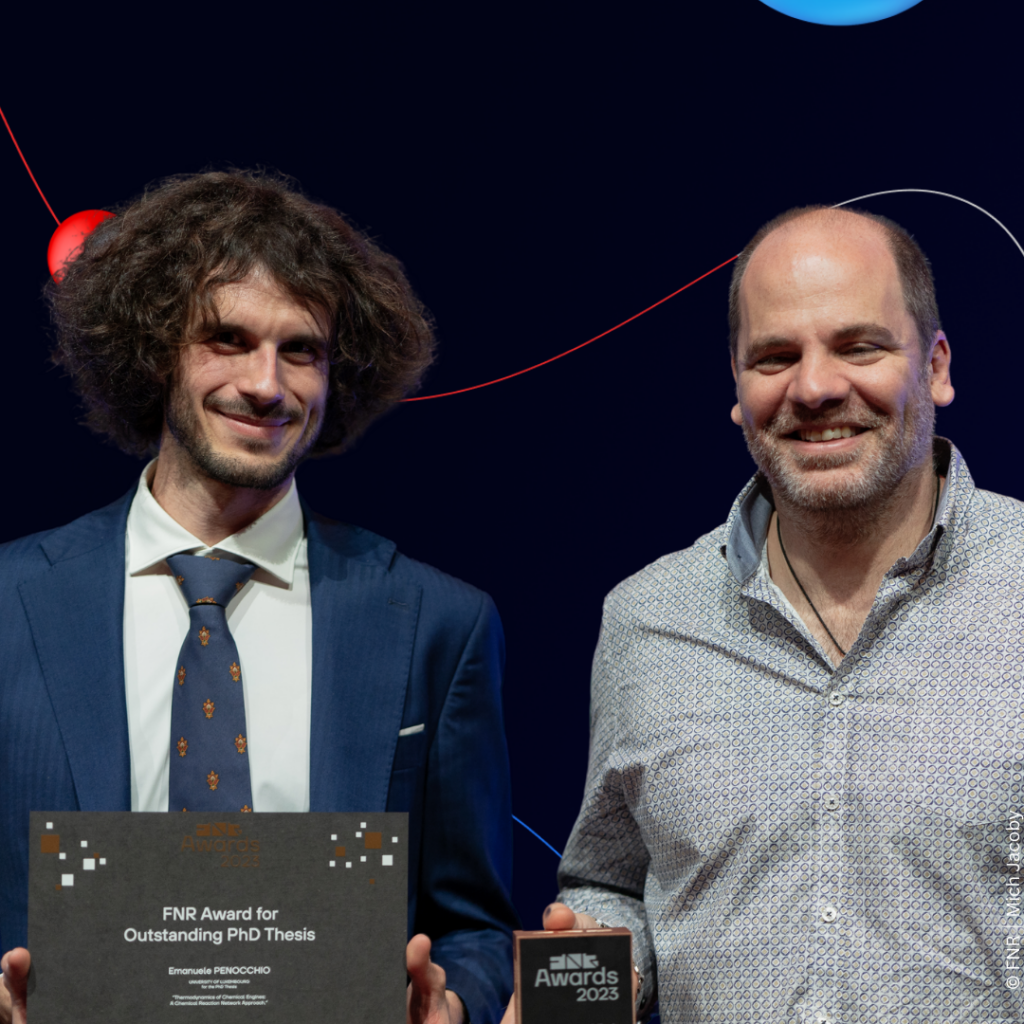10 selected Research Luxembourg results – September 2023
23 October 2023

Luxembourg News in Science & Research
Customised molecules; the allergy rate in Luxembourg; the cardiovascular repercussions of COVID; decarbonizing the steel industry; the connection between diet and Parkinson’s disease: here are the latest scientific news updates from Luxembourg.
Iván Herrador, “Venus over Belval”; Christine Berthel; Flickr; Pixabay; Craiyon (Diane Bertel)
Will we soon be able to create molecules “à la carte”?
Department of Physics and Materials Science (DPhyMS), University of Luxembourg
Designing a molecule exactly as desired, with all the desired properties, could become a reality, with multiple implications – in pharmacology and beyond. The team led by Prof. Tkatchenko at the University of Luxembourg has been able to formulate a new scientific law, the “freedom of design,” which brings us closer to this possibility.
Their research focused on the extensive study of molecules containing up to 7 heavy atoms (non-hydrogen). They came to the surprising conclusion that there are very few limitations preventing a molecule from simultaneously exhibiting a pair of different quantum mechanical properties. Conversely, they found a significant number of structurally distinct molecules sharing multiple quantum mechanical properties. These two findings led to the formulation of the “freedom of design” law, indicating that, in theory, the possibilities of molecular creation are infinite.
The researchers used the QM7-X dataset for this purpose, an extension of a quantum chemistry dataset (QM7) containing information on over 7,000 organic molecules, including structure, formation energy, and dipole moment.
To the press release / To the publication
What is the allergy rate in Luxembourg?
Luxembourg Institute of Health (LIH)
Nearly half of the Luxembourgish population would show signs of allergy. Two departments at the LIH (the Department of Infection and Immunity and the Department of Precision Health) were able to make this observation by studying Immunoglobulins IgE (a type of antibody) in the Luxembourgish population in relation to the overall health profile of the country.
A dataset of 480,000 data points was collected from 1,462 adult residents. 44% tested positive for IgE antibodies, with respiratory allergies being predominant. The most common causes of allergies were tree pollen, grass, and dust mites.
According to the authors, the youngest participants (25-34 years) formed the category with the most medical needs related to allergies; they also experienced the most lifestyle changes and loss of biodiversity, a connection that deserves further research.
To the press release / To the publication
Heat2Power, a new tool to decarbonize the steel industry
Luxembourg Institute of Science and Technology (LIST)
Heat2Power is a new software developed by LIST and ArcelorMittal to help companies convert the heat lost during industrial production processes (through cooling water, gaseous effluents produced during various thermal processes) into energy.
This otherwise lost heat can be recovered using heat exchangers (devices for heat exchange between two liquids), allowing for energy transfer to other processes in the plant. But to calculate the best possible combinations of technology and operating conditions, a very large number of variables must be considered (over 6,000 for ArcelorMittal in Luxembourg, for example), which is nearly impossible to calculate mentally for engineers. The Heat2Power software comes to their aid. It identifies the optimal parameters for achieving maximum conversion efficiency, using mathematical programming processes.
Heat2Power is part of ArcelorMittal’s transition process toward decarbonizing the steel industry.
Can the cardiovascular repercussions of COVID be detected?
Luxembourg Institute of Health (LIH)
A new diagnostic test will soon be able to identify patients at risk of developing cardiovascular problems following an infection with SARS-CoV-2.
As part of the “COVIRNA” project, funded by the European Commission, the LIH’s cardiovascular research unit has identified RNA molecules in patients with a strong capacity to predict the severity of SARS-CoV-2 infection, as well as mortality. Researchers had access to demographic and clinical data from patients (specifically, blood samples from existing cohorts: about 2,000 COVID-19 patients and 500 healthy donors) and then created predictive models based on artificial intelligence.
Even though the pandemic may be over, healthcare systems worldwide are currently battling the scourge of Long COVID and its various complications, including cardiovascular, neurological, and metabolic. Therefore, such a diagnostic test is highly valuable.
To the press release / To the publication
A new equipment to optimise substrate coating
Luxembourg Institute of Science and Technology (LIST)
Anyone who has ever painted leaves or applied glue to tracing paper knows that applying a coating to a surface can sometimes be a major technological challenge. Therefore, the new LIST equipment in this field is particularly interesting.
It’s a new “PVD line” (Physical Vapor Deposition), a device used in metallurgy and manufacturing to apply thin coatings to various substrates. With a length of 18 meters, it can accommodate substrates of approximately 1.6 meters by 1.2 meters, making it ten times larger than typical laboratory installations. The substrates can be made of glass, sheets, plastics, metals, ceramics, and more.
This PVD line also adapts the coating process for temperature-sensitive materials. It allows the deposition of extremely thin layers, each with different properties, including optical, electronic, and anti-corrosion attributes.

What is the connection between diet and Parkinson’s disease?
Luxembourg Centre for Systems Biomedicine (LCSB)
A new study conducted by the LCSB explores the intriguing gut-brain axis, this time in the context of Parkinson’s disease. Researchers examined the specific influence of diet on the gut microbiome in mice. They found that gut dysbiosis (pathological alteration of the flora) caused by a low fiber intake reduces the gut’s barrier function and increases the exposure of neurons in the digestive and central nervous systems to toxins. This exacerbates the symptoms of the disease.
The study was conducted using a mouse model. Among the notable results, the reduction in levels of Lactobacillus (a genus of probiotic bacteria with neuroprotective functions that can improve the integrity of the gut barrier) and the Lachnospiraceae NK4A group showed an inverse correlation with the risk of developing dementia or Parkinson’s disease.
A vaccine against bronchiolitis
Luxembourg Superior Council for Infectious Diseases – Ministry of Health
A new vaccine called Beyfortus (composed of the monoclonal antibody Nirsevimab) is now available against the respiratory syncytial virus RSV, which is responsible for bronchiolitis and newborn pneumonia. In a recent publication, the Luxembourg Superior Council for Infectious Diseases calls for passive immunization of at-risk children starting this winter. A single intramuscular injection in the fall covers the entire season.
RSV causes a wave of hospitalizations in infants every winter (3% of infected children). Children at risk are those born during the high circulation period of the virus (October to March), all infants under 6 months, and those with underlying conditions that increase the risk of severe RSV infection (immunocompromised, congenital heart disease carriers…).
RSV is the second leading cause of infectious mortality in children aged 1 to 12 months worldwide, second only to malaria.
A new network for the management of neurodegenerative diseases
“ParkinsonNet Luxembourg,” a national competence network (including neurologists, nurses, physiotherapists, occupational therapists, etc.) on neurodegenerative diseases, was launched on September 26. Its aim is to provide better care for people with these conditions by pooling various types of expertise, which are often complementary. The pilot project has proven successful over the past six years, incorporating scientific advancements from NCER-PD.
There has been a significant increase in the number of people diagnosed with Parkinson’s disease (source: NCER-PD), in part due to the aging population. The causes are multifactorial, ranging from environmental factors to genetic predisposition and lifestyle influences. To optimize individual patient care, the pooling of scientific expertise is essential.
To the press release / More information
What is the real purchasing power like in Luxembourg?
The sharp rise in prices related to the energy crisis is being felt in our daily lives. Faced with this urgency, STATEC has refined its analyses of changes in purchasing power, aiming to address some concerns.
The results are encouraging for Luxembourg: real disposable income has increased by 35% since 1995; the average purchasing power per person has risen by nearly €2,000 between 2019 (the year prior to the successive crises of the pandemic and the war in Ukraine) and 2023. STATEC defines disposable income as “the total income of households (wages, pensions, social benefits, etc.) from which social contributions and taxes are subtracted.” This increase can be attributed in part to more restrained inflation and wage growth that is more dynamic compared to neighbouring countries.
Some statistics on the elderly population in Luxembourg
There are over 136,000 seniors (aged 60 and above) residing in Luxembourg, of whom 7% have never used the internet, and only 46% were employed in 2022 (compared to the European average of 62%). Life expectancies at birth are 84.8 years for women and 80.5 years for men born in Luxembourg (a consistent increase).
On the other hand, while 6 in 10 seniors report being in good health, 43% consume alcohol more than once a week, and 13% drink alcohol every day (compared to 8% for the overall population). Additionally, 40% are overweight. These are the latest statistics from STATEC on the aging population in the Grand Duchy.
To the publication (in French)
Author: Diane Bertel









